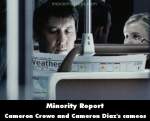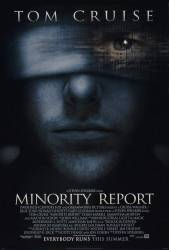Trivia: Paul Thomas Anderson, who directed Tom Cruise in Magnolia, has a cameo on the train. It is reported that he is so hard to find that Anderson himself does not know where he appears.

Trivia: On the "subway" train, the man holding the USA Today paper is Cameron Crowe, and the woman in the seat behind him on his left is Cameron Diaz. Because "Vanilla Sky" and "Minority Report" were so close in shooting, the two directors (Crowe and Spielberg) agreed to put themselves as cameos in each other's films. (00:46:10)
Trivia: The flames in the fire at the end of the film when the camera pans out of the cottage are in the shape of AI, Speilberg's previous film!
Trivia: The author has given the three pre-cogs the first names of famous crime writers: Agatha (Christie), Dashiell (Hammett) and (Sir) Arthur (Conan Doyle).
Trivia: When John takes Agatha from PreCrime, Colin Farrell asks how much time do they have before John commits his murder, he is answered "51 minutes and 28 seconds", the time remaining until the end of the movie.
Trivia: The man that is being told "You're the man!" in the club that John takes Agatha to is Scott Frank, the writer of the movie.
Trivia: On the DVD extras, the sound designer for Minority Report explains that he stuck a contact mike on his fancy new washing machine to obtain the sound samples that became the sounds made by the maglev cars. In the scene where maglev cars race down the side of a skyscraper, when Anderton is standing on one end of his maglev car, so that it is now carrying an unbalanced load, you can hear the EXACT unmodified noise of a washing machine when it has an unbalanced load. (00:44:32)
Trivia: The guy that plays the hotel clerk, the one that Anderton pulls the gun on in order to see the registration on the computer, is really Tom Cruise's cousin. He is best known for his role as the killer in "In The Bedroom".
Trivia: In the short story, Anderton was overweight, balding, and middle aged. Nothing to do with Tom Cruise.






Answer: Because subverting the expectations of the viewer makes it more interesting. The audience (and potentially John) are set-up to expect bad things, which don't happen. Once the "bad thing" happened, the suspense would be gone and everyone could relax. Expecting something bad but knowing when it might happen maintains the tension.